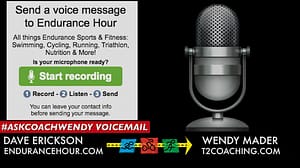I strive for efficiency in all aspects of my life, especially my sport. Despite being my favorite sport, compared to my competitors, cycling is my weakest part of triathlon. I really enjoy “lazy” rides, going farther, faster, then I can walking or running. After countless events that I lost because of my slower bike splits, I know I was missing something in my cycling training. I invested in a professional bike fit, did countless hours of drills and hills and started training with a power meter. Becoming efficient on the bike not only equates to a stronger and faster cyclist, it also translates to a more efficient run off the bike.
- The first step in being efficient on your bike is to have a professional bike fit. A good fit may include changes in your saddle height, fore/aft position, stem length, seat angle, stack and reach. All are important for comfort, aerodynamics and producing more force to your pedals.
- Once you know the bike fits you, balancing left- and right-leg strength with proper pedaling mechanics, you’re on your way to becoming more powerful and expending less effort. As with learning any new skill, focusing on various aspects of the pedal stroke is an important part of training. Just like in swimming and running, I recommend doing pedaling drills to help you to learn to efficiently apply force to the pedals. Sample Pedaling drills are found below.
- Next you want to build miles on your legs. While Keeping a efficient cadence, develop your engine with a training plan that combines a mix of endurance, strength and speed workouts
- Train with a power meter, really, the best way to measure your workout load and give you honest feedback.
As with swimming and running, technique-based cycling drills break down the stroke, allowing you to focus on and improve one piece of this complex movement at a time, helping you to learn to efficiently apply forces to the pedals.
Whether in the pool, running, or riding, many times we’re tempted to just grind out the hours and miles as we train, but that overlooks the importance of technique – and, if you are training inefficiently, and racing inefficiently, you are costing yourself energy and time, as well as preventing yourself from being comfortable, competing better and having more fun.
Cycling drills, such as focused on the four phases of the pedal stroke, can be an essential contributor to pedal stroke efficiency. Pedal stroke efficiency reduces the wear on muscular endurance and demands less energy, and as a result improves overall cycling performance.
Pedal stroke is critical because it provides the power that propels the bicycle. In order to increase efficiency, it’s important to incorporate drills that work the hip flexors so they are trained to lift during the recovery phase of the stroke.
There are four phases of the pedal stroke: The downstroke, backstroke, upstroke and over-the-top stroke. Practicing these can improve your movement and efficiency. For the most part, 360 degrees of various pressure points of force.
Downstroke
The downstroke is where the foot and pedal move from 0 to 180 degrees (12 o’clock to 6 o’clock). The motion of the foot should be directed forward and downward during the downstroke.
Backstroke
The backstroke overlaps with the end of the downstroke and the beginning of the upstroke. The motion is mostly horizontal, and is made by pulling backward and upward from approximately 120 to 220 degrees (4 to 8 o’clock).Note that as the one foot and pedal are entering the downstroke, the other is entering the over-the-top stroke. I emphasize the backstroke in specific technique workouts.
Upstroke
The upstroke emphasizes pulling upward from 270 to 360 degrees, the last 90 degrees of the pedal rotation, from 9 o’clock to 12 o’clock. This phase is easiest to focus on while riding out of the saddle on hills or in a high gear with high resistance on a trainer.
Over-the-top stroke
The over-the-top stroke precedes the downstroke. pressing forward over the top from about 320 to 20 degrees, or from 10 o’clock to 2 o’clock.
Once you develop pedaling technique you can apply it during every training session to develop your engine. An efficient cadence is around 85-95 rpms. High-cadence pedaling works your cardiovascular system more, but reduces the relative intensity of the leg muscles. The key, then, is pedaling with enough cadence to keep your watts-per-pedal-stroke at a level that your muscles can handle, but at a cadence that will not overload your cardiovascular system. The optimal balance is different for every rider. Each athlete must experiment to find the cadence that works best for them. Your natural cadence can be changed with repetition in training.As with swimming and running, drills are an important part cycling training, as part of your warm-up, a weekly indoor trainer workout, or during cool-down following your training rides.
Check out t2coaching and Endurance Hour’s Multi-Media Training Programs. Have a question, leave us a voicemail form your desktop, laptop or mobile device.

